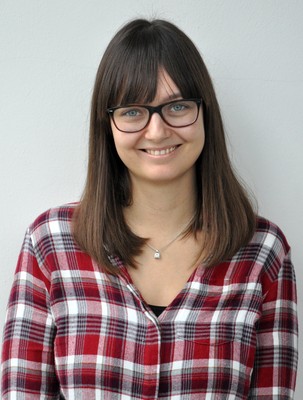Katharina Schuhladen
Katharina Schuhladen
Doktorandin
Development and characterization of new formulations of bioactive glasses for soft tissue engineering and wound healing
Betreuer: Prof. Dr.-Ing. habil. Aldo R. Boccaccini
Due to their characteristic mechanical properties and inorganic nature, bioactive glasses (BGs) have been considered suitable biomaterials for applications in bone repair and replacement. Therefore, the use of bioactive glasses in soft tissue engineering and wound healing has been less investigated. However, some properties of bioactive glasses based on their high surface reactivity, which are necessary for hard tissue repair, make them also interesting for applications in soft tissue repair, as reviewed in the literature [1]. Moreover, it is well known that BGs can release in controlled way biologically active ions (B, Li, Cu, etc.) which are capable of stimulating wound healing being angiogenic and antibacterial [2,3]. The aim of this research project is the design, fabrication and characterization of a new family of BGs incorporating multiple biologically active ions (also known as bioinorganics), to use them for the fabrication of flexible composites for wound healing and soft tissue engineering applications.
[1] Miguez-Pacheco V, Hench LL & Boccaccini AR: Bioactive glasses beyond bone and teeth: Emerging applications in contact with soft tissues. Acta Biomaterialia 13 (2015) 1-15.
[2] Zhao, S., et al., Wound dressings composed of copper-doped borate bioactive glass microfibers stimulate angiogenesis and heal full-thickness skin defects in a rodent model. Biomaterials 53 (2015) 379–391.
[3] Haro Durand, LA, et al., In vitro endothelial cell response to ionic dissolution products from boron-doped bioactive glass in the SiO2–CaO–P2O5–Na2O system. J. Mater. Chem. B 2 (2014) 7620-7630.
2022
- , , , :
BIOACTIVE GLASSES AND THE IMMUNE SYSTEM: RECENT FINDINGS AND FUTURE PERSPECTIVES
In: TISSUE ENGINEERING PART A, NEW ROCHELLE: 2022
2021
- , , , , , :
Effect of buffer in simulated body fluid on morphology and crystallinity of hydroxyapatite precipitated on 45S5 bioactive glass-derived glass–ceramic scaffolds: comparison of Good's buffer systems and TRIS
In: Materials Today Chemistry 21 (2021), Art.Nr.: 100527
ISSN: 2468-5194
DOI: 10.1016/j.mtchem.2021.100527 - , , , :
The effect of borate bioactive glass on the printability of methylcellulose-manuka honey hydrogels
In: Journal of Materials Research (2021)
ISSN: 0884-2914
DOI: 10.1557/s43578-021-00256-9 - , , , , , , , :
Influence of the replacement of silica by boron trioxide on the properties of bioactive glass scaffolds
In: International Journal of Applied Glass Science (2021)
ISSN: 2041-1286
DOI: 10.1111/ijag.15894
2020
- , , , , , :
Sol-gel coatings incorporating borosilicate bioactive glass enhance anti corrosive and surface performance of stainless steel implants
In: Journal of Electroanalytical Chemistry 876 (2020), Art.Nr.: 114735
ISSN: 1572-6657
DOI: 10.1016/j.jelechem.2020.114735 - , , , , , :
Electrospun PCL/PGS composite fibers incorporating bioactive glass particles for soft tissue engineering applications
In: Nanomaterials 10 (2020), Art.Nr.: 978
ISSN: 2079-4991
DOI: 10.3390/nano10050978 - , , , , , , , :
Borate and silicate bioactive glass coatings prepared by nanosecond pulsed laser deposition
In: Coatings 10 (2020), S. 1-13
ISSN: 2079-6412
DOI: 10.3390/coatings10111105 - :
Development of multifunctional wound dressings by using newly designed ion-doped borosilicate and borate bioactive glasses (Dissertation, 2020) - , :
Bioactive glass variants for tissue engineering: From the macro- to the nanoscale
Elsevier, 2020
ISBN: 9780081029992
DOI: 10.1016/B978-0-08-102999-2.00015-6 - , , , , :
Comparison of the influence of 45s5 and Cu-containing 45s5 bioactive glass (BG) on the biological properties of novel Polyhydroxyalkanoate (PHA)/BG composites
In: Materials 13 (2020), Art.Nr.: 2607
ISSN: 1996-1944
DOI: 10.3390/ma13112607 - , , , , :
Manuka honey and bioactive glass impart methylcellulose foams with antibacterial effects for wound-healing applications
In: Biomedical Materials 15 (2020)
ISSN: 1748-6041
DOI: 10.1088/1748-605X/ab87e5 - , , , , , :
Cu, Zn doped borate bioactive glasses: antibacterial efficacy and dose-dependent in vitro modulation of murine dendritic cells
In: Biomaterials Science 8 (2020), S. 2143-2155
ISSN: 2047-4830
DOI: 10.1039/c9bm01691k - , , , , :
Production of a novel poly(ɛ-caprolactone)-methylcellulose electrospun wound dressing by incorporating bioactive glass and Manuka honey
In: Journal of Biomedical Materials Research Part B: Applied Biomaterials (2020)
ISSN: 1552-4973
DOI: 10.1002/jbm.b.34690 - , , , , , , :
Calorimetric approach to assess the apatite-forming capacity of bioactive glasses
In: Journal of Non-Crystalline Solids 550 (2020), Art.Nr.: 120290
ISSN: 0022-3093
DOI: 10.1016/j.jnoncrysol.2020.120290
2019
- , , , , , , :
Highly porous polymer-derived bioceramics based on a complex hardystonite solid solution
In: Materials 12 (2019), Art.Nr.: 3970
ISSN: 1996-1944
DOI: 10.3390/ma122333970 - , , , , , :
Interaction of MOPS buffer with glass-ceramic scaffold: Effect of (PO4)(3-) ions in SBF on kinetics and morphology of formatted hydroxyapatite
In: Journal of Biomedical Materials Research Part B: Applied Biomaterials (2019)
ISSN: 1552-4973
DOI: 10.1002/jbm.b.34530 - , , , , , , , , , , :
Electrophoretic Deposition of Bioadaptive Drug Delivery Coatings on Magnesium Alloy for Bone Repair
In: ACS Applied Materials and Interfaces 11 (2019), S. 8625-8634
ISSN: 1944-8244
DOI: 10.1021/acsami.9b01227 - , , , , , :
Bioactive glass based scaffolds coated with gelatin for the sustained release of icariin.
In: Bioactive Materials 4 (2019), S. 1-7
ISSN: 2452-199X
DOI: 10.1016/j.bioactmat.2018.10.001 - , :
Bioactive glasses as angiogenic agents for tissue engineering
In: Rui L. Reis (Hrsg.): Encyclopedia of Tissue Engineering and Regenerative Medicine, Elsevier, 2019, S. 33-39 (Reference Module in Biomedical Sciences, Bd.1-3)
DOI: 10.1016/B978-0-12-801238-3.11115-8 - , , :
Bioactive glasses meet phytotherapeutics: The potential of natural herbal medicines to extend the functionality of bioactive glasses
In: Biomaterials 217 (2019), Art.Nr.: 119288
ISSN: 0142-9612
DOI: 10.1016/j.biomaterials.2019.119288 - , , , , , , , :
Gelatin coating increases in vivo bone formation capacity of three-dimensional 45S5 bioactive glass-based crystalline scaffolds
In: Journal of Tissue Engineering and Regenerative Medicine 13 (2019), S. 179-190
ISSN: 1932-6254
DOI: 10.1002/term.2780
2018
- , , , :
Dissolution of borate and borosilicate bioactive glasses and the influence of ion (Zn, Cu) doping in different solutions
In: Journal of Non-Crystalline Solids 502 (2018), S. 22-34
ISSN: 0022-3093
DOI: 10.1016/j.jnoncrysol.2018.08.037

